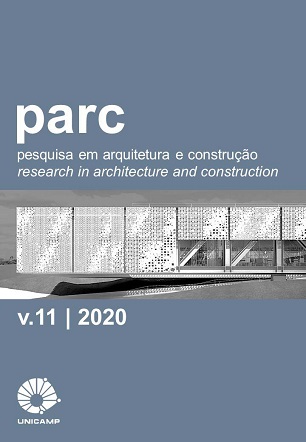Abstract
Normative Instruction 02/2014 was published in 2014 by the Ministry of Planning, Development, and Management. It binds building design and retrofit of public buildings with more than five hundred square meters of area, to be developed according to the National Label of Energy Conservation level A of the Technical Standards for the Quality of Commercial, Services and Public Buildings (RTQ-C). This paper’s objective is to verify if the energy efficiency level in classroom buildings, which were bidden by Federal Institutions of Higher Learning (IFES), meets the NI’s resolutions and, if not, how they can be improved. Following RTQ-C’s protocol, ten naturally ventilated buildings, bidden by four different IFES, were analyzed. Simulations were run verifying the hypothetical energy expenditure if the buildings were air-conditioned. As a result, 60% of the buildings met the highest grade of energy efficiency, complying with the NI. In non-compliance, small modifications such as the replacement of fluorescent light tubes by LED lights and dual flush toilets are enough for the projects to reach the level A-label.
References
ABNT - ASSOCIAÇÃO BRASILEIRA DE NORMAS TÉCNICAS. NBR 9077. Saídas de emergência em edifícios. Rio de Janeiro: ABNT, 2001.
ABNT - ASSOCIAÇÃO BRASILEIRA DE NORMAS TÉCNICAS. NBR 15220. Desempenho Térmico de Edificações. Parte 2: Métodos de cálculo da transmitância térmica, da capacidade térmica, do atraso térmico e do fator solar de elementos e componentes de edificações. Rio de Janeiro: ABNT, 2005a.
ABNT - ASSOCIAÇÃO BRASILEIRA DE NORMAS TÉCNICAS. NBR 15220. Desempenho Térmico de Edificações. Parte 3: Zoneamento bioclimático brasileiro e diretrizes construtivas para habitações unifamiliares de interesse social. Rio de Janeiro: ABNT, 2005b.
ABNT - ASSOCIAÇÃO BRASILEIRA DE NORMAS TÉCNICAS. NBR 16401. Instalações de ar condicionado – Sistemas centrais e unitários. Parte 2: Parâmetros de conforto térmico. Rio de Janeiro: ABNT, 2008.
ARAÚJO, João L. A questão do investimento no setor energético brasileiro: reforma e crise. Nova Economia, Belo Horizonte, v.11, n. 1, p. 77-96, jul. 2001. Disponível em: https://revistas.face.ufmg.br/index.php/novaeconomia/article/view/382. Acesso em: 7 ago. 2020.
ASHRAE - AMERICAN SOCIETY OF HEATING, REFRIGERATING AND AIR-CONDITIONING ENGINEERS. Thermal Environmental Conditions for Human Occupancy. Atlanta: ASHRAE, 2010, 54p.
BRASIL, CASA CIVIL. Lei nº 10.295, de 17 de outubro de 2001. Dispõe sobre a Política Nacional de Conservação e Uso Racional de Energia e dá outras providências. Diário Oficial da União. Brasília, DF, 18 de outubro de 2001.
BRASIL, MINISTÉRIO DO MEIO AMBIENTE. A3P – Agenda Ambiental na Administração Pública. 5a. ed. Brasília, DF, 2009.
DE DEAR, Richard J.; BRAGER, Gail S. Thermal comfort in naturally ventilated buildings: revisions to ASHRAE Standard 55. Energy and Buildings, v. 34, n. 6, p. 549-561, 2002. DOI:https://doi.org/10.1016/S0378-7788(02)00005-1
EPE - EMPRESA DE PESQUISA ENERGÉTICA. Balanço energético nacional 2018: ano base 2017, Rio de Janeiro: EPE, 2018. Disponível em: https://www.epe.gov.br/sites-pt/publicacoes-dados-abertos/publicacoes/PublicacoesArquivos/publicacao-303/topico-419/BEN2018__Int.pdf. Acesso em: 7 ago. 2020.
FOSSATI, M.; LAMBERTS, R. Eficiência energética da envoltória de edifícios de escritórios de Florianópolis: discussões sobre a aplicação do método prescritivo do RTQ-C. Ambiente Construído, Porto Alegre, v. 10, n. 2, p. 59-69, abr. / jun. 2010.
INMETRO – INSTITUTO NACIONAL DE METROLOGIA, NORMALIZAÇÃO E QUALIDADE INDUSTRIAL. Requisitos Técnicos de Qualidade para o Nível de Eficiência Energética de Edifícios Comerciais, de Serviços e Públicos. Eletrobrás, 2010.
NAKAMURA, N. K.; MACIEL, L. F.; CARLO. J. C. Impactos de medidas de conservação de energia propostas no PBE Edifica para o nível de eficiência energética de envoltórias de um edifício naturalmente condicionado. Ambiente Construído, Porto Alegre, v. 13, n. 4, p. 105-119, out./dez. 2013. DOI:https://doi.org/10.1590/S1678-86212013000400008
OLIVEIRA, B. S.C.M. de; SANTOS, L. M. L. dos. Compras públicas como política para o desenvolvimento sustentável. Revista Administração Pública, Rio de Janeiro, n. 49, p. 189-206.
PORTAL DE COMPRAS DO GOVERNO FEDERAL. Disponível em: http://www.comprasgovernamentais.gov.br. Acesso em: 02/05/2018.
PROCELINFO - CENTRO BRASILEIRO DE INFORMAÇÃO DE EFICIÊNCIA ENERGÉTICA. Sobre o Procel, Edificações, [s.l], 2006. Disponível em: http://www.procelinfo.com.br. Acesso em: 2 mai. 2018.
SILVA, P. L.; PAGEL, E. C. Eficiência energética em edifícios públicos: um estudo de caso na sede do DETRAN/ES. ENCONTRO NACIONAL DE CONFORTO NO AMBIENTE CONSTRUÍDO. 14. Balneário Camboriú. Anais [...]. Balneário Camboriú: UNIVALI, ANTAC. 2017, p. 1479-1488.
I accept that PARC Research in Architecture and Building Construction journal perform, on the original file approved for publication, revisions and modifications in orthoghaphic, grammar and standard issues.
I give to PARC Research in Architecture and Building Construction journal the rights of first publication of the revised version of my paper, licensed under the 'Creative Commons Attribution' license (which allows sharing the work with the recognition of first authorship and publication in this journal).


